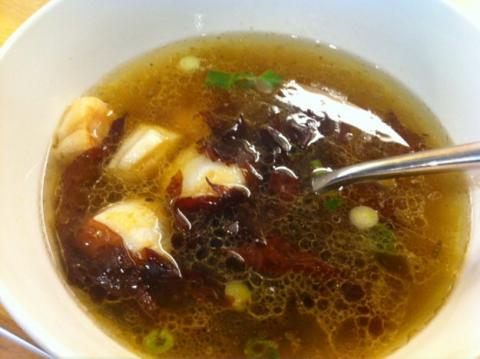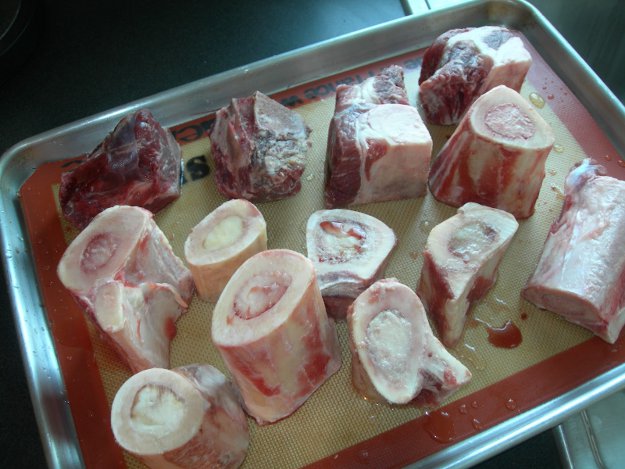Drink to Your Health: How the Bone Broth Trend Gained Momentum

Bone broth was the first big food trend in 2015, and so far, it’s stuck. Though not everyone has replaced their morning coffee with chicken broth, the trend has appeared on restaurant menus, in health advice columns and has even inspired its own recipe books.
An incredibly simple and primitive idea, serving bone broth dates back to mid-18th century France, where it was served at inns and known as a restoratif, inspiring the word ‘restaurant.’
Now broth and brodo are the popular terms being used. ‘Broth’ comes from the same Proto-Germanic root as the Old English ‘brew’ and refers to “...liquid in which something has been boiled,” according to the Online Etymology Dictionary. ‘Brodo’ is the Italian word for broth. Nonbelievers have pointed out that these terms are just fancy ways of saying ‘stock.’ (See Twitter account @StockStickler.)
In November, Marco Canora, chef of Hearth in New York City, opened Brodo, a to-go window at his East Village restaurant serving broth in coffee cups. The shop’s slogan is “the world’s first comfort food.” Cups of broth run between $4 for an 8-oz chicken broth and $9 for a gingered grass-fed beef broth. To-go sizes of 32 ounces are also available. Options like extra bone marrow and fermented beet juice are offered as add-ins for 75 cents each.
His broths are cooked for 24 hours or longer. Lines of people flocked to Brodo during New York City’s freezing winter, and in January the New York Times’ Julia Moskin declared it “...a trend beverage, ranking with green juice and coconut water as the next magic potion in the eternal quest for perfect health.”
The Secret’s in the Soup
It’s what’s inside the bone that counts. The bone provides minerals, amino acids and collagen. A long cooking time of six to 24 hours and addition of acid (such as apple cider vinegar or wine) releases these nutrients to be absorbed into the body.
Broth is said to have a variety of benefits, including relief from digestive troubles, strengthening bones, improving kidney function, relief from joint pain, and all-around detox for the body. It’s also a sustainable choice for the environment, epitomizing the idea of utilizing every part of an animal. Of course, not all of these benefits have been proven by scientific evidence, as mentioned by a February NPR article. Scientific research on bone broth remains minimal as of now.
That hasn’t stopped its influence on foodie and health food culture. Broth has been deemed the ultimate health tonic, used by people like Kobe Bryant, who uses it as a staple in his diet both at home and on the road.
Chris Chen is an acupuncturist in New York City, and he recommends bone broth to his clients. He learned about it in 2007 when he studied acupuncture in Seattle and lived in a mostly Korean community.
“Every part of Korean food is about health and wellness and virility,” Chen said. “One of the foods that made me feel the best was seolleongtang - bone soup. I’d been vegetarian for a while, but noticed that food made me feel great.”
Aside from the broth tasting good, Chen said it calmed his anxiety and prevented his carb cravings. His joints started feeling better, too.

“At 33 my joints are better now than when I was 18,” he said. “Even if you’re healthy it’ll help you.”
The elixir is prevalent in other cultures, from Jewish “penicillin” to Japanese tonkotsu and many others. The trend is really nothing new, but the idea of drinking it multiple times per day as a health tonic is new to American culture.
The Buzz
The trend isn’t just hitting the East Coast. You can grab broth at Belcampo in Los Angeles and Jola Cafe in Portland. Belcampo serves it as a side dish ($3.50) at its restaurants.
But making broth isn’t all bones and water. Well, it is, but Chen said acquiring quality bones from small farmers is getting more difficult as demand rises.
His wife co-owns broth distribution company Bone Deep and Harmony, which he said is selling around 400-500 pounds of broth monthly.
The bones have to be cut, frozen and vacuum-packed, according to USDA guidelines, he said.
Greg Spielberg, founder of Imagination in Space, headed a bone broth festival in March in New York City to get people trying a variety of local broths.
“One camp is saying it’s another hipster invention. One is saying there are a lot of really good benefits from bone broth,” Spielberg said. “That argument never really gets resolved online and doesn’t really matter. We wanted people to try and see for themselves.”
The reaction to the event was “super positive,” he added. He thinks the trend will grow, as it uses ingredients most chefs already have and is easy to make.
“People are a little bit uncomfortable supporting something that doesn’t have weight behind it. If you promote it ,then people become super-excited about it. I imagine it was the same with yoga and healthy food in its early days,” he said.

So how will the trend shape up now that it’s spring? In New York City, record low temperatures and snowy days meant broth was the perfect choice as a winter warmer. Chen isn’t sure if Americans will maintain interest in warmer months.
“In other cultures warm hot broth is a constant all year round, but because it’s such a trend here I’m not sure,” Chen said.
Either way, if you’re making broth, Chen suggests three rules. Don’t oversalt it, drink it warm, and don’t forget to add an acid. Cheers to good health.
Author Bio:
Beth Kaiserman is Highbrow Magazine’s chief food critic.




























































































































































































































































































































